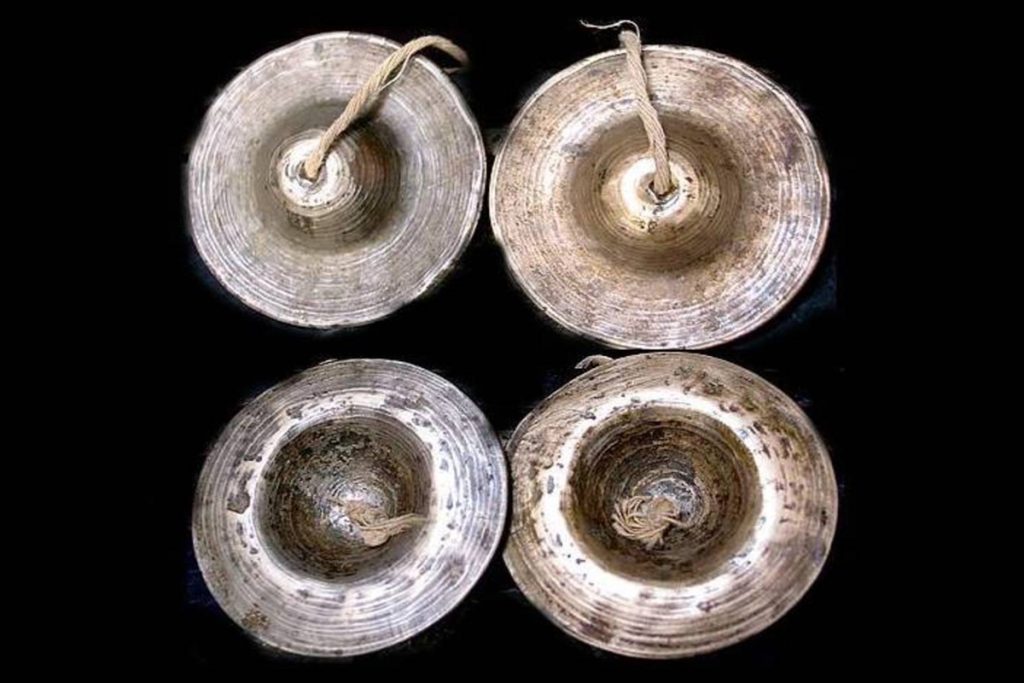ខេត្តប៉ៃលិន ជារតនមណ្ឌលដែលមានព្រំប្រទល់ជាប់នឹងប្រទេសថៃឡង់ដ៍សម្បូណ៌ទៅដោយរ៉ែត្បូងដ៏មានតម្លៃ។ ធនធាននេះត្រូវបានជនជាតិខ្មែរកូឡា ដែលមានដើមកំណើតជាជនជាតិភូមា និងបានមករស់នៅក្នុងតំបន់នេះជាច្រើនជំនាន់មកហើយ។ របរចិញ្ចឹមជីវិតសំខាន់ជាងគេរបស់ជនជាតិខ្មែរកូឡា គឺការជីកយករ៉ែត្បូងដ៏មានតម្លៃ។
ខ្ញុំបានរៀបរាប់នៅក្នុងអត្ថបទពីមុនហើយថា ខេត្តប៉ៃលិនក៏មានរបាំក្ងោកមួយ ដែលគេហៅថា «របាំក្ងោកប៉ៃលិន»។ របាំនេះត្រូវបានគេនិយាយថានាំមកនូវភាពសប្បាយរីករាយនិងភាពចម្រុងចម្រើនដល់អ្នកស្រុកអ្នកភូមិ។ ហេតុដូច្នេះហើយ បានជាយើងឃើញនៅក្នុងភូមិស្រុកនាខេត្តប៉ៃលិន នាសម័យមុនសង្គ្រាមនិងរបបប្រល័យពូជសាសន៍ខ្មែរក្រហម របាំនេះត្រូវបានគេសម្តែងក្នុងពិធីបុណ្យចូលឆ្នាំ និងឱកាសផ្សេងៗទៅតាមតម្រូវការ។

(ប្រភព៖ Pinterest)
តាមសេចក្តីឱ្យការណ៍របស់លោក ហង់ សំហឿន ធ្វើការនៅសាលាខេត្តបាត់ដំបង ហើយមានបេសកកម្មទៅធ្វើការនៅសាលាស្រុកប៉ៃលិន (១៩៦០-១៩៦៣) នៅក្នុងអំឡុងទសវត្ស១៩៦០ ជនជាតិកូឡានៅរតនមណ្ឌល (បច្ចុប្បន្ន ខេត្តប៉ៃលិន, ពេលនោះ ខេត្តបាត់ដំបង) និយមលេងភ្លេងរបស់ជាតិគេម្យ៉ាង ហៅថា «ភ្លេងអូស៊ី» ជាភាសាខ្មែរយើងហៅថា «ភ្លេងស្គរ»។ ភ្លេងស្គរនេះមានគ្រឿង ៤ យ៉ាងគឺ៖ អូស៊ី ឬ ស្គរ ១, នែ ឬ ស្រឡៃ ១, សែង ឬ ឈឹង ឆាប ២ (ធំ១ តូច១), ម៉ង ឬ គង ១, និង អ្នកច្រៀងម្នាក់។

(ប្រភព៖ Horniman Museum)
អូស៊ី ជាភាសាភូមា (ភាសាកូឡា, កងកូនយ៉ាវ និង ភាសាខ្មែរ, ស្គរ)។ អូស៊ី ឬស្គរ មានសណ្ឋានទ្រង់ទ្រាយដូចស្គរឆៃយ៉ាំខ្មែរយើងបេះបិទ តួស្គរនេះធ្វើដោយឈើ ពាសដោយស្បែកគោ មានបណ្តាយប្រវែងប្រមាណ ១ ម៉ែត្រ។ នៅពេលលេង គេយកខ្សែមកពាក់ស្ពាយឆៀង វាយនឹងដៃដូចស្គរឆៃយ៉ាំដែរ។
ឧបករណ៍ផ្លុំហៅថា នែ (ភាសាខ្មែរហៅថា ស្រឡៃ)។ ស្រឡៃនេះមានទំហំតូចជាងស្រឡៃខ្មែរយើង មានរន្ធខ្យល់ ៧ នៅខាងលើ រន្ធមួយទៀត នៅខាងពោះ ប្រហែលគ្នានឹងប៉ីបបុស (ប្របុស) ខ្មែរដែរ និងមានសូរដូចស្រឡៃខ្មែរ។ តួស្រឡៃធ្វើដោយឈើ មានវិជ្ឈមាត្រ ០ម០៣ និង មានប្រវែង ០ម៣០។ នៅខាងចុងមានបន្តប្រដាប់ម្យ៉ាងធ្វើដោយស្ពាន់ រឹង មានរាងដូចមាត់ត្រែ ប្រវែងប្រមាណ ០ម២០ និងទទឹងមាត់ប្រមាណ ០ម២០ ដើម្បីពង្រឹកសម្លេងឱ្យបានឮខ្លាំង។ តែប្រដាប់ពង្រីកសំឡេងនេះ មិនមួលភ្ជាប់ទៅនឹងតួស្រឡៃទេ គឺគេទុកឱ្យរលុង គ្រាន់តែមានខ្សែចងភ្ជាប់ទៅនឹងតួស្រឡៃ កុំឱ្យរបូតតែប៉ុណ្តោះ។ អណ្តាតនែ ធ្វើដោយស្លឹកត្នោតឬស្លឹកចារ មានប្រវែងប្រមាណ ០ម០៥។
ឧបករណ៍តន្ត្រី ដែលជនជាតិកូឡាហៅថា «សែង» ភូមាហៅថា ឡាហ្គុន ភាសាខ្មែរ ហៅថា «ឈឹង ឬ ឆាប»។ សែង មានពីរយ៉ាង៖ ម្យ៉ាងខ្នាតធំ មានទទឹងមាត់ប្រមាណ ០ម១៥ និងម្យ៉ាងទៀតខ្នាតតូច មានទទឹងមាត់ ០ម១០ ធ្វើពីសំរឹទ្ធ រាងសំប៉ែតជាងឈឹងរបស់ខ្មែរយើងបន្តិច។ ពេលលេង សែងខ្នាតធំនិងខ្នាតតូចបង្កើតជាស្នូរខុសគ្នា មួយមានសូរស្រួយ មួយមានសូរគ្រលរ។ ចំណែកឯឧបករណ៍ ម៉ង ភូមាហៅថា«ម្ហោង»។ បើមើលទៅ ម៉ង ឬ ម្ហោងនេះ មិនខុសអ្វីអំពីគងខ្មែរយើងទេ តែម៉ងច្រើនធ្វើដោយសំរឹទ្ធ និងមានវិជ្ឈមាត្រប្រមាណ ០ម៤០។
ជនជាតិកូឡា ច្រើននិយមយកវង់ភ្លេងអូស៊ីទៅលេងនៅពេលរាំរបាំក្ងោក ពេលធ្វើបុណ្យចេញវស្សា បុណ្យខែផល្គុន និងបុណ្យបំបួសនាគ។ ក្នុងវង់ភ្លេងនេះ ត្រូវមានអ្នកច្រៀងម្នាក់ ច្រៀងជាភាសាភូមា។

ជនជាតិកូឡា មានវង់ភ្លេងមួយវង់ទៀតឈ្មោះថា ភ្លេងកងម៉ងសឹង ដែលគេនិយមលេង កំដរឱ្យស្រីប្រុសនាំគ្នារាំលេងកម្សាន្តនៅពេលបុណ្យទានម្តងៗ។ វង់ភ្លេងនេះ មានតែស្គរធំវែង១ និង គងចំនួន ៦ ឬ ៧ ប៉ុណ្តោះ។ កងម៉ងសឹង ជាស្គរមានរាងរៅប្រហែលគ្នានឹងសម្ភោររបស់ខ្មែរដែរ ខុសគ្នាតែមានខ្សែព្យួរសំយ៉ុងពាក់នៅកអ្នកវាយ និងវែងជាងសម្ភោរបន្តិច។ ស្គរនេះ មានប្រវែងប ១ម២០ និង វិជ្ឈមាត្រ ០ម៣០។ គេអាចដាក់ស្គរផ្ទាល់នៅដី ហើយវាយក៏បាន ពាក់ឆៀងលើស្មាវាយក៏បាន ព្រោះស្គរនេះពុំមែនធំណាស់ណាទេ ថែមទាំងស្រាលផង។ គេវាយស្គរនេះដោយដៃហើយវាយតែមុខម្ខាងប៉ុណ្ណោះ។
នាសម័យបុរាណ វង់ភ្លេងនេះ ត្រូវមានម៉ងឬគងចំនួន២០ ពីធំមកតូច។ តែក្រោយមក គេមានប្រើតែគង ៦ ឬ ៧ ប៉ុណ្តោះ។ ចំណែកឯអ្នកទៅលេងបុណ្យដែលចូលរាំទាំងស្រីទាំងប្រុស គឺគេរាំជាគូៗ ប្រុសមួយស្រីមួយក៏បាន រាំតែស្រីៗក៏បាន តែគេពុំរាំវិលវង់ដូចខ្មែរយើងរាំវង់ទេ។ ឯចង្វាក់ស្គរនោះក៏មិនញាប់ផងដែរ។ អ្នកដែលមិនចូលរាំ គេមិនគ្រាន់តែឈរមើលទទេៗទេ តែគេតែងតែជួយទះដៃជាចង្វាក់បន្ទរថែមផង ដើម្បីលើកទឹកចិត្តអ្នករាំឱ្យរឹតតែសប្បាយរីករាយឡើង។
ក្រៅពីភ្លេងទាំងពីរបែប ដែលបានអធិប្បាយខាងលើនេះ ជនជាតិកូឡានិយមលេងភ្លេងខ្សែដែរ តែបណ្តាសម្ភារៈភ្លេងទាំងនោះ ពុំមានទ្រសោ ឬ ទ្រឆេទេ។ គ្រឿងខ្សែឯទៀតៗជាគ្រឿងរបស់ខ្មែរទាំងអស់។ ម្យ៉ាងទៀតដែលគួរឱ្យកត់សម្គាល់ដែរគឺ ក្រុមភ្លេងខ្សែរបស់ជនជាតិកូឡា មិនលេងបទខ្មែរសម័យទេ គេនិយមលេងតែបទខ្មែរបុរាណ មានបទអណ្តើកស៊ីត្រកួន ជាដើម។ ជនជាតិកូឡា យកលំនាំភ្លេងតាមភូមាទាំងអស់ សូម្បីតែគ្រឿងភ្លេង ក៏ជនជាតិនេះទៅទិញពីប្រទេសភូមាមកដែរ។ ដើម្បីជាការគិតពិចារណា យើងឃើញថាវង់តន្ត្រីកំដររបាំក្ងោកប៉ៃលិន ដែលនៅសម្តែងរហូតដល់សព្វថ្ងៃនៅកម្ពុជា គឺមាន៖ ស្គរឆៃយ៉ាំ១ ស្គរភ្លោះ១គូ ស្រឡៃប៉ៃលិន១ ឆាប២គូ គងម៉ង់១ និងអ្នកច្រៀងម្នាក់។ ឯវង់តន្ត្រី អូស៊ី មានឧបករណ៍ អូស៊ី (ដូចស្គរឆៃយ៉ាំ) នៃ (ដូចស្រឡៃប៉ៃលិន) សែង (ដូចឆាប ឈឹង) ម៉ង (ដូចគងម៉ង់) និងអ្នកច្រៀងម្នាក់ដូចគ្នា។ ជាការសោកស្តាយណាស់ ដែលវង់តន្ត្រីនិងឧបករណ៍តន្ត្រីខាងលើមិនមានវាសនាបន្តជីវិត រូបភាព និងសកម្មភាពរបស់ខ្លួននៅកម្ពុជាយើងជាបន្ត ដោយសារកត្តាអវិជ្ជមានផ្សេងៗ៕
——————————-
KULA MUSIC OF PAILIN PROVINCE
The region of Pailin, which borders upon Thailand, is rich in precious stones. This resource is exploited by the Kula-Khmer, who are of Burmese origin, and who have inhabited this region for generations. Their major activity is precious stone mining, and they are consequently known as masters of this trade.
In Pailin, a peacock dance is also found; it is called the Peacock of Palin Dance. This dance is said to bring happiness and prosperity to villagers. For that reason, as we see in the locality, the dance is performed during New Year or on special occasions when called for. The accompanying music ensemble includes a long drum, a twin-double-headed barrel drum called skor pluoh, a shawm, two pairs of cymbals of different sizes, one medium-sized knobbed gong, and a vocalist.
According to the report by Mr. Hang Samhoeurn of Battambang province, who was posted in Pailin from 1960-1963, in the 1960s, there was a Kula ethnic group inhabiting the Pailin region. They often performed their national music known as Ozi, consisting of four musical instruments: Ozi (long drum), Nei (shawm), Saeng (cymbals), Mang (small gong), and a singer. The Kula frequently used the Ozi ensemble to accompany the Peacock Dance during the ending of the Buddhist Lent, Lunar Festival, and ordination ceremony. This ensemble included a singer who sang in Burmese.
The Kula had another ensemble called “Kang Mong Seong” that they used as dance accompaniment during festive times. This ensemble had 1 long drum and 6 or 7 gongs. Kang Mong Seong is a type of drum that physically resembles the Khmer drum sampo (double-headed barrel drum. The drum can be laid on the floor or worn on the shoulder to play with one hand and only on one side.
In the olden days, this ensemble used to have 20 mongs or gongs, ranging from big to small. In time, it only used 6 to 7 gongs to play. As for the people who went to the festivals, both women and men dance in pairs; a man dances with a woman or women dance in pairs. However, they did not dance in a circle like Khmer dance. For those who did not participate in the dance, they did not just stand and watch, they would clap their hands to the rhythm of the music to encourage those who danced.
Apart from these two types of ensembles that are mentioned above, the Kula liked to play string instruments as well. Although there were not Khmer high-pitched two-stringed fiddles, the other strings were Khmer instruments. The Kula string ensemble did not play modern Khmer songs, they only did the traditional Khmer, such as Andoeurk Si Trakuon or Turtle Eating the Morning Glory. The Kula used Burmese songs in their repertoire, and they only purchased their instruments from Burma.
Taking into consideration, we see that the ensemble accompanying the Peacock of Pailin Dance that is still performed today in Cambodia consists of 1 Chhaiyaim drum, 1 twin-drum, 1 Pailin sralai, 1 pair of finger-cymbals, 1 small knobbed gong, and a singer. Similarly, the Ozi ensemble had instruments, such as Ozi (Chhaiyaim drum), Nei (Pailin sralai), Saeng (cymbals), Mong (gong), and a singer. It is unfortunate that the aforementioned Kula (Burmese) ensembles and instruments are no longer in use and existence today in Cambodia due to various negative factors.
អត្ថបទដើម៖ បណ្ឌិត សំ សំអាង






